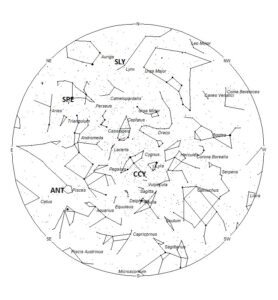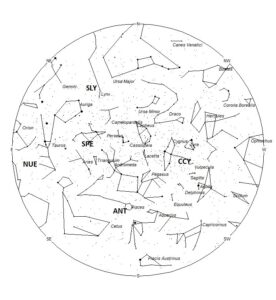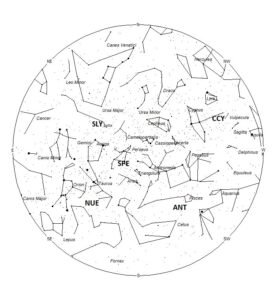During this period, the moon reaches its first quarter phase on Wednesday September 11th. At that time the moon will lie 90 degrees east of the sun in the sky and will set near 22:00 Local Summer Time (on September 10th). This weekend the waxing crescent moon will set during the evening hours and will not interfere with meteor observing during the more active morning hours. The estimated total hourly rates for evening observers this weekend should be near 4 as seen from mid-northern latitudes (45N) and 3 as seen from tropical southern locations (25S) For morning observers, the estimated total hourly rates should be near 16 as seen from mid-northern latitudes (45N) and 10 as seen from tropical southern locations (25S). The actual rates seen will also depend on factors such as personal light and motion perception, local weather conditions, alertness, and experience in watching meteor activity. Evening rates are reduced due to moonlight. Note that the hourly rates listed below are estimates as viewed from dark sky sites away from urban light sources. Observers viewing from urban areas will see less activity as only the brighter meteors will be visible from such locations.
The radiant (the area of the sky where meteors appear to shoot from) positions and rates listed below are exact for Saturday night/Sunday morning September 7/8. These positions do not change greatly day to day so the listed coordinates may be used during this entire period. Most star atlases (available at science stores and planetariums) will provide maps with grid lines of the celestial coordinates so that you may find out exactly where these positions are located in the sky. I have also included charts of the sky that display the radiant positions for evening, midnight, and morning. The center of each chart is the sky directly overhead at the appropriate hour. These charts are oriented for facing south but can be used for any direction by rotating the charts to the desired direction. A planisphere or computer planetarium program is also useful in showing the sky at any time of night on any date of the year. Activity from each radiant is best seen when it is positioned highest in the sky, either due north or south along the meridian, depending on your latitude. Radiants that rise after midnight will not reach their highest point in the sky until daylight. For these radiants, it is best to view them during the last few hours before dawn. It must be remembered that meteor activity is rarely seen at its radiant position. Rather they shoot outwards from the radiant, so it is best to center your field of view so that the radiant lies toward the edge and not the center. Viewing there will allow you to easily trace the path of each meteor back to the radiant (if it is a shower member) or in another direction if it is sporadic. Meteor activity is not seen from radiants that are located far below the horizon. The positions below are listed in a west to east manner in order of right ascension (celestial longitude). The positions listed first are located further west therefore are accessible earlier in the night while those listed further down the list rise later in the night.

22:00 Local Summer Time

01:00 Local Summer Time

04:00 Local Summer Time
These sources of meteoric activity are expected to be active this week
.
The chi Cygnids (CCY) were discovered on the night of 14/15 September 2015, when a weak outburst of meteors occurred where none had been observed before. Since then, little activity has been detected until August of 2020, when another mini outburst of possible CCY activity occurred south of the normal radiant between the constellations of Delphinus and Aquila. Some astronomers believe this early appearance may herald another return of the CCY’s from their normal radiant in southern Cygnus. Nothing unusual occurred in September 2020, but activity from this source should be monitored, nonetheless. The most probable dates of this occurring would be on the nights from September 12-14. At that time the radiant should be located near 20:00 (300) +31, a position 3 degrees southeast of the variable star chi Cygni. An easier method of locating the radiant would be to draw an imaginary line from the bright stars Albireo (beta Cygni) to Aljanah (epsilon Cygni). The radiant lies just short of the half-way point of this line. These meteors can be seen all night long but are best seen near 22:00 LST when the radiant lies nearly overhead as seen from the northern hemisphere. Rates are expected to be low but anyone seeing any of these meteors should report them to the International Meteor Organization on an online visual meteor report form. With an entry velocity of 19 km/sec., the average meteor from this source would be of very slow velocity. Unfortunately, these meteors are not well seen from the southern hemisphere as Cygnus does not rise high into the sky from those locations.
The large Anthelion (ANT) radiant is currently centered at 23:52 (358) -01. This position lies in western Pisces, 3 degrees southeast of the 4th magnitude star known as lambda Piscium. This radiant is best placed near 02:00 LST when it lies on the meridian and is highest in the southern sky. Rates at this time should be near 2 per hour as seen from the northern hemisphere and 2 as seen from south of the equator. With an entry velocity of 30 km/sec., the average Anthelion meteor would be of medium-slow velocity.
The September epsilon Perseids (SPE) are active from September 2-23, with maximum activity occurring on the 9th. The current position of the radiant lies at 03:06 (046) +39. This area of the sky lies in southern Perseus, near the 3rd magnitude star known as Gorgonea Tertia (rho Persei). To best see these meteors, face half-way up toward the northeast during the last few hours prior to dawn. Rates at this time may be near 2 per hour as seen from the northern hemisphere and less than 1 as seen from south of the equator. There have been outbursts from this source in the past, but none are predicted for this year. With an entry velocity of 64 km/sec., the average meteor would be of swift velocity.
The nu Eridanids (NUE) were co-discovered by Japanese observers using SonotoCo and Jürgen Rendtel and Sirko Molau of the IMO. Activity from this source stretches from August 31 to September 21. The main maximum activity occurs on September 10th. A secondary maximum occurs on September 16th. The radiant currently lies at 04:26 (067) 00, which places it in northeastern Eridanus, 4 degrees northwest of the 4th magnitude star known as nu Eridani. Observers concentrating on this activity should face half-way up in the southern sky during the last dark hour prior to dawn to best view these meteors. Current rates are expected to be less than 1 per hour during this period no matter your location. With an entry velocity of 66 km/sec., the average meteor from this source would be of swift velocity.
The September Lyncids (SLY) are active from August 30th through September 20th with maximum activity occurring on September 10th. The radiant is located at 06:59 (105) +55, This position lies in western Lynx, 4 degrees south of the 4th magnitude star known as 15 Lyncis. To best see these meteors, view half-way up in the northern sky during the last hour prior to dawn. Rates are expected to be less than 1 per hour. With an entry velocity of 60 km/sec., the average meteor from this source would be of swift velocity. The meteors are not readily visible from the southern hemisphere as the radiant does not rise high enough before the onset of dawn.
Sporadic meteors are those meteors that cannot be associated with any known meteor shower. All meteor showers are evolving and disperse over time to the point where they are no longer recognizable. Away from the peaks of the major annual showers, these sporadic meteors make up the bulk of the activity seen each night. As seen from the mid-northern hemisphere (45N) one would expect to see during this period approximately 11 sporadic meteors per hour during the last hour before dawn as seen from rural observing sites. Evening rates would be near 2 per hour. As seen from the tropical southern latitudes (25S), morning rates would be near 7 per hour as seen from rural observing sites and 1 per hour during the evening hours. Locations between these two extremes would see activity between these listed figures.
The list below offers the information in tabular form of the showers that I feel are within reach of the visual observer to discern. Hourly rates are often less than one, so these sources are rarely listed as visual targets in most meteor shower lists. If you are like me and wish to associate as many meteors as possible with known sources, then you will appreciate these listings. Before listing meteors from these obscure sources, you should attempt to prove these meteors belong to them and are not chance alignments of sporadic meteors. You can note parameters such as duration, length, radiant distance and the elevation of each meteor to help compute the probability of shower association. It should be remembered that slow meteors can be seen from fast showers, but fast meteors cannot be produced from slow showers. Slower showers are those with velocities less than 35/km per second. Slow meteors can appear from fast showers when they appear close to the radiant or low in the sky. The table located on page 22 of the IMO’s 2024 Meteor Shower Calendar is a big help in aiding in the identification of meteors. If you record the length and duration of each meteor, you can use this chart to check the probability of the meteor belonging to a shower of known velocity. If the angular velocity is similar to the figure in the table, then your meteor probably belongs to that shower. Rates and positions are exact for Saturday night/Sunday morning.
| SHOWER | DATE OF MAXIMUM ACTIVITY | CELESTIAL POSITION | ENTRY VELOCITY | CULMINATION | HOURLY RATE | CLASS |
| RA (RA in Deg.) DEC | Km/Sec | Local Summer Time | North-South | |||
| chi Cygnids (CCN) | Sep 13 | 19:44 (296) +30 | 19 | 22:00 | <1 – <1 | IV |
| Anthelions (ANT) | – | 23:52 (358) -01 | 30 | 02:00 | 2 – 2 | II |
| September epsilon Perseids (SPE) | Sep 09 | 03:06 (046) +39 | 64 | 05:00 | 2 – <1 | II |
| nu Eridanids (NUE) | Sep 10 | 04:26 (067) 00 | 65 | 07:00 | <1 – <1 | IV |
| September Lyncids (SLY) | Sep 10 | 06:59 (105) +55 | 60 | 09:00 | <1 – <1 | IV |
You can keep track of the activity of these meteor showers as well as those beyond the limits of visual observing by visiting the NASA Meteor Shower Portal. You can move the sky globe to see different areas of the sky. Colored dots indicate shower meteors while white dots indicate sporadic (random) activity. The large orange disk indicates the position of the sun so little activity will be seen in that area of the sky.
Class Explanation: A scale to group meteor showers by their intensity:
- Class I: the strongest annual showers with Zenith Hourly Rates normally ten or better.
- Class II: reliable minor showers with ZHR’s normally two to ten.
- Class III: showers that do not provide annual activity. These showers are rarely active yet have the potential to produce a major display on occasion.
- Class IV: weak minor showers with ZHR’s rarely exceeding two. The study of these showers is best left to experienced observers who use plotting and angular velocity estimates to determine shower association. These weak showers are also good targets for video and photographic work. Observers with less experience are urged to limit their shower associations to showers with a rating of I to III.

